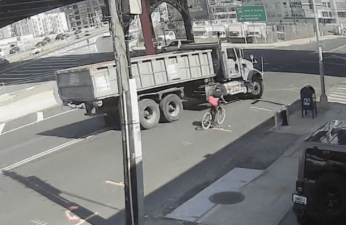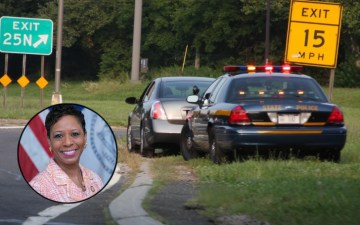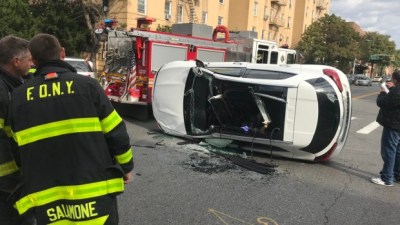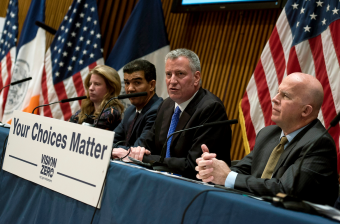‘A Muscular Approach’: Mayor Doubles Down on NYPD Involvement in Traffic Stops, Dismisses Lander Proposal
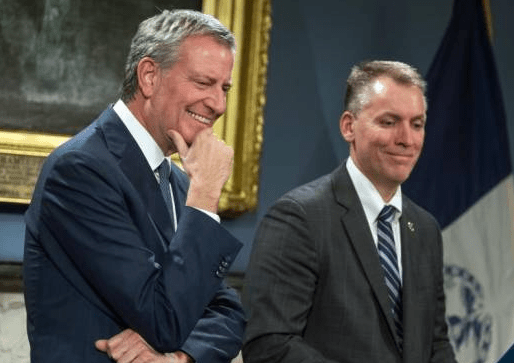
In cops he trusts.
Mayor de Blasio dismissed a proposal by Council Member and Comptroller candidate Brad Lander to reduce the role of the NYPD in traffic stops, enforcement and crash investigation, calling it “counter-productive” and maintaining that Vision Zero requires “a very muscular approach by law enforcement.”
Under questioning by Streetsblog on Monday, the mayor denied the thrust of Lander’s proposal, namely that the NYPD does a bad job of investigating crashes and cracking down on reckless driving, a job much better suited to experts at the Department of Transportation.
“I’d certainly want the NYPD to be as rigorous as possible, [so] I’m not sure the answer is to just send it to DOT and everything’s OK,” the mayor said.
“I want a very muscular approach by law enforcement to addressing when someone has recklessly harmed another human being. So taking the NYPD out of the equation actually is counter-productive. Making sure there are enough investigations and rigorous enough investigations and tough-enough follow through by the NYPD and prosecutors is essential.”
Streetsblog reminded the mayor that the NYPD’s Collision Investigation Squad only analyzes a tiny fraction of the thousands of serious crashes per year, and the mayor said he is “very open to” the idea of adding “more personnel” to the NYPD crash team — something the agency told the City Council last year that it did not want.
The mayor did say that he wanted better communication from the NYPD to the DOT after crashes so that investigators tell road designers any relevant information gleaned from the crash site — such as how a bad road design contributed to the collision. This currently doesn’t happen.
The city must be “maximizing the role of DOT on the follow through when we find a problem that emerges from a crash and shows the need for greater change,” he said.
But on the substance of the Lander proposal, the mayor did not seem interested. It’s likely that the mayor feels sufficiently proud of his Vision Zero effort — which has built scores of miles of protected bike lanes and dedicated bus lanes, reduced speed limits, and, in general, reduced fatalities from many hundreds to several hundreds per year — that he does not think it needs improvement.
But Lander’s proposal [PDF] laid out many, many shortcomings of the mayor’s effort, specifically where NYPD is involved:
- The agency is a “grudging participant in Vision Zero,” Lander said, which is backed by Streetsblog’s reporting.
- Less than 1 percent of the drivers in tens of thousands of hit-and-run crashes per year getting ID’d and then arrested, as City Limits reported.
- The agency hands out tickets pedestrians and cyclists in a documented racially biased manner.
- The Collision Investigation Squad has a windshield-perspective bias that leads to infrequent charges against drivers and botched investigations.
The problem? If Lander becomes Comptroller, he would take office on the same day that de Blasio leaves office, essentially putting the proposal in the hands of the next mayor, whoever he or she might be. Streetsblog reached out to all of the currently declared leading candidates for comment on the Lander plan. Only Council Member Carlos Menchaca and the campaign of Maya Wiley responded.
“Lander’s proposal is rooted in advocate voice and I applaud it,” Menchaca said. “Defunding the police means we need to transition to more none-police solutions, these proposals like removing police from traffic enforcement are productive steps toward that goal. These are the kind of solutions New Yorker’s deserve.”
Wiley, a former de Blasio administration counsel, said the following in a statement from her campaign: “Maya cares deeply about improving the safety of our streets so that Vision Zero is not just a slogan but an actual policy goal, which is why she has previously spoken about how traffic enforcement is an example of something that should not be an NYPD function.”
Lander criticized the mayor more specifically.
“I’m glad the mayor recognizes that the current enforcement by the NYPD is not working, but doubling down on a ‘muscular approach to law enforcement,’ (especially not when that looks like blaming victims, targeting cyclists, and confiscating delivery bikes), is not the best way to make our streets safer,” the Park Slope Democrat said. “Far better would be to double down on preventative measures, including life-saving infrastructure to protect pedestrians and cyclists and the data-driven, driver accountability program that the Mayor signed into law but has failed to fund.”
The would-be city accountant also pointed out that he and City Council candidate Tiffany Caban witnessed the NYPD’s ham-fisted approach firsthand over the weekend:
Right as we were there, NYPD officers deployed to the intersection summonsed & confiscated the moped of another immigrant deliver driver.
I asked about truck enforcement.
They said the problem was the mopeds. pic.twitter.com/JESyJM3elX
— Brad Lander (@bradlander) November 15, 2020
So with most mayoral candidates observing radio silence, that left advocates to slam the mayor for his bias in favor of law enforcement, even in something so removed from policing as road design and automated enforcement.
“The mayor and his police department have had seven years to strengthen the city’s response to drivers who kill and injure,” said Jon Orcutt, a former city transportation official who is now with Bike New York. “With traffic fatalities on the rise for a second straight year, it’s time for a new approach.”
Charles Komanoff, who has long advocated for the Collision Investigation Squad to be completely reimagined, did notice that the mayor admitted that “there is a bias in the American legal system for the motorist in a way that does not value human life enough” — and saw an opening.
“It’s good to see the mayor decry pro-motorist bias in the American legal system and call for change,” said Komanoff, the lead author of “Killed By Automobile.” “The best way for him to move the ball forward is to release all CIS reports over the past dozen years — a period covering his two terms and Bloomberg’s last. Experts and advocates can then determine if this pro-motorist bias has pervaded NYPD’s crash investigations, and in what ways.”
Most observers have long ago concluded that such a bias has already infected the NYPD — and the mayor won’t fight it.
“What we need from Mayor de Blasio is less talk and more action to save Vision Zero and save lives,” said Marco Connor DiAquoi of Transportation Alternatives. “The mayor inexplicably removed modest yet crucial life-saving funding for the Dangerous Vehicle Abatement Program, a program that would have forced thousands of the most dangerous drivers to take a proven safe-driving course and would have seized the vehicles of the worst repeat offenders — without exposing people to the criminal justice system. As speeding has increased during COVID, and we are on track to see the most traffic fatalities during his tenure, the mayor needs to do something.”
